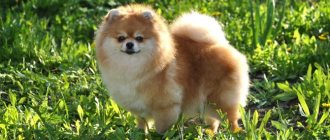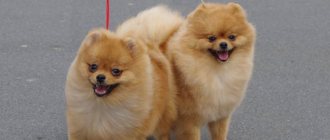Positive sides
Cheerfulness
They not only look like smiling, bouncy balls, they are. Spitz are very optimistic and active. Very active, tireless dogs, distinguished by good health and endurance.
Mind
Spitz are very smart and easy to train, even if the owner does not have such experience. They grasp everything on the fly.
Security skills
Spitz dogs have no hunting instinct. They are guards. Natural distrust of strangers and deep affection for their owner and their family make them excellent watchdogs. Spitz dogs signal any intrusion into their territory with a loud bark.
Loyalty and empathy
Representatives of this breed become very attached to all household members and are able to capture the slightest nuances of a person’s mood. They perfectly adapt to the needs of the owners.
Respectful attitude towards children
Spitz are very patient and gentle with children. They can allow children a lot, and will never bite. Here, sometimes it is more important to raise a child than a dog that resembles a toy, so that the latter does not get hurt.
How not to wean yourself: common mistakes
Dog owners often make common mistakes. The animal should associate the owner's hands with exclusively positive emotions; they should calm the raging four-legged friend calmly, and in no case using physical force.
It is not recommended to deliberately play pranks on a puppy, as this encourages the animal to start hunting, growling, snarling and biting on instinctive levels. For games you need to use special toys - dog balls and ropes.
Flaws
"Galatiness"
All Spitz owners note their passion for loud barking.
This habit must be fought from the very first day the dog appears in the house, otherwise it can become a real problem.
Cockiness
These dogs have pronounced leadership qualities. They are fearless, and do not take their small size into account too much. They are capable of attacking a dog much larger than themselves and getting hurt.
Manipulation
Yes, on the one hand, intelligence and well-developed empathy help Spitz dogs quickly learn commands and be good to others, but on the other hand, these same qualities make them subtle manipulators. If you give up some slack in raising this dog, he will take the position of master of the house.
Suspicion
Spitz dogs are extremely wary of strangers. This can cause problems with guests coming into the house. If you do not initially teach your dog to behave calmly around strangers, the pet may attack people and even bite.
All the shortcomings of the breed are easily corrected by proper and timely education. This list simply draws attention to areas that require special attention when training.
What does a barking spitz mean?
Barking is a verbal method that dogs use to communicate with each other and with humans. Every time behind the usual “woof” there is some information or emotion of the animal. Scientists have long found out that domesticated animals bark more often because they have to convey their desires to their owners. In the wild, representatives of “canines” rarely use bark.
Dogs are capable of making different sounds over a wide range and can easily change timbre. In addition to barking, they howl, whine, squeal, and growl. Each intonation is accompanied by corresponding movements of the ears and tail. If you are attentive to your pet, you can easily guess what he wants to convey to others.
Reasons why a Spitz barks
What can a dog's bark express?
- joy (when meeting the owner, from the delicacy received, during the game);
- a warning for those who have crossed the boundaries of the dog-protected area;
- aggressive attitude;
- asking for food and water;
- call to play;
- attracting the owner's attention;
- request to go outside;
- pain, discomfort (cold, heat);
- fear, despair;
- anxiety, stress;
- boredom, melancholy;
- communication with others like you (social barking).
What determines the barking of a Spitz dog?
If you pay close attention to your pet, you can determine what the dog wants by the nature of the sounds it makes. Barking speaks volumes about the animal's emotional state.
- A strong fright is indicated by a long, loud bark that turns into a squeal.
- Low, rough sounds indicate an aggressive mood.
- Rare joyful “woofs” - the dog wants to play or is happy about the owner’s return.
- The intervals between “woofs” have become shorter, the volume of sounds is increasing - the Spitz has sensed danger and is preparing to defend itself.
- Lingering sounds that turn into howls indicate hunger, cold, melancholy and loneliness.
- Fear is indicated by random barking and squealing. The tail is lowered at this time.
- Noise sounds turning into a menacing roar - the animal is threatening, ready to defend its owner and territory.
- Loud barking followed by puppy yelps most often occurs in dogs during play.
Important: dogs have a unique ability to change the timbre of their voice without tension. Their barking can be divided into melodic and noise.
Features of boys and girls
To put it briefly, boys are beautiful, and girls are kind.
This is, of course, a joke, but not so far from the truth.
Males definitely look more luxurious. At the same time, they are more cocky and love to fight. Spitz boys are more willful and stubborn than girls. But at the same time they are straightforward and open.
Difficulties associated with high libido may arise. They can mark territory, so you will have to walk with a boy more often than with a girl.
Well, having met a beautiful lady on the street, a Spitz is able to forget about everything that connected you and plunge headlong into passion. For a while, of course. But it’s still worth taking care of microchipping your dog in case he gets lost.
Girls of this breed are traditionally considered softer and more flexible. They have no problems with the litter box. They are easier to train and do not run into conflicts with other dogs. On the other hand, girls are cunning and tend to manipulate their master.
Another feature that is worth taking into account, although it is not related to the character, is a long heat cycle. For three weeks the dog will require close attention, special panties and walking on a leash.
Expenses
Also, the high price of Pomeranians is influenced by the costs of breeders. Dog breeding is a very expensive undertaking, where expenses only begin with the purchase of a dog. Due to the fact that the kennel buys mainly dogs for breeding, their cost is initially high. Therefore, before putting puppies up for sale, the breeder spends money on:
- a breeding bitch with an interesting origin and appearance;
- food, professional cosmetics, veterinary services;
- regular exhibitions to obtain titles;
- payment for mating;
- childbirth with the participation of a veterinarian;
- activation, nutrition, vitamins for puppies.
For every step you have to pay, and gradually expenses from tens of thousands of rubles turn into hundreds. Mating even with a “domestic” male dog costs about 500 euros. If the breeder wants to add imported blood and chooses an imported producer, then the payment is at least 1000 euros. And the money is in advance, no one will wait until the bitch gives birth and the breeder sells the litter.
Pomeranians often cannot give birth on their own. The breeder must be constantly on alert and call a veterinarian to the house at any time. And you only need an excellent professional who not only has the appropriate education, but also has experience in giving birth to small breeds. A cesarean section may also be required, which is not at all uncommon among Spitz dogs. If you count all the expenses, the question of the high price of puppies disappears by itself.
How does it change with age?
Puppies
Puppies are usually taken from breeders at around 3 months of age. This is no accident. At this age, Spitz puppies are in the so-called “imprinting phase” (4 – 7 weeks). They actively learn about the world around them and acquire skills that will likely remain with them for the rest of their lives. Having met the future owner during this period, the dog fits him into his picture of the world.
- Week 8-12 – Socialization phase. A very important stage of growing up. Relationships are formed between the dog and the owner, other family members and pets, if any.
- Weeks 13-16 – Phase of defining social roles. This is where the Spitz can try to “bend” the owner and other household members. He has begun a “transitional age”; he is fighting for leadership and independence. During this period, it is especially important to be very consistent in the requirements for the dog, to ensure compliance with established rules and obedience.
- 5-6 month. The phase of establishing hierarchical order. The trends of the past period are even stronger. A teenage Spitz requires a lot of attention and firmness from its owner.
- 7-9 months – puberty. The bitches are in their first heat, and the males begin to mark their territory. This is not yet adulthood, it’s too early for the first mating. Experts recommend breeding dogs of this breed from the age of 12 months for males and from 15 months for females.
Adult dogs
Mature Spitzes become more balanced and perceive temporary loneliness more calmly. With proper upbringing, they stop showing bad habits and reveal themselves in all their charm.
Old
The first signs of aging appear by age 7. However, this is more about health. Aging has virtually no effect on the character of Spitz dogs.
Spitz can be lively, active and active until a very old age, and they live longer than large dogs. Some even up to 20 years old.
History of the breed
Those who just want to get a dog of this breed, or already have one, probably cannot even imagine that the ancestors of these fluffy little ones were many times larger, tougher and lived in the north. Thanks to archaeological excavations, it was possible to find out that their ancestors were the so-called turf dogs, which were used for movement.
Everything began to change dramatically during the Middle Ages. Their appearance and energy attracted special attention from European aristocrats. Noble people increasingly began to show off not only their beautiful dresses, but also their little furry companions. According to history, the inhabitants of Germany can be called the discoverers of the Pomeranian Spitz as a small domestic dog. It was in this country, at the turn of the 17th-18th centuries, that breeding of the Spitzhund breed began, which later spread throughout all nearby countries.
It is worth noting that the first Spitz weighed about 15 kilograms! Therefore, dog breeders who were breeding this breed selected the smallest individuals and tried to get a more compact litter.
The fate of this breed changed the moment the British Queen Victoria saw a Pomeranian named Marco . The Queen could not resist his charm, so he soon went home with her, where the breeding business was continued. Since then, these dogs have become regulars at various exhibitions. They received a lot of awards, won international competitions, thanks to which a dog breeders club appeared at the end of the 19th century. Only wealthy ladies and representatives of noble families could enter it. They not only organized various competitions for dogs, but also founded many nurseries where Spitz dogs were bred and kept. By the way, at that time each kennel was breeding dogs of a certain color.
The efforts of English dog breeders did not go unnoticed. At the end of the 19th century, America became interested in the breed. Spitz were brought to the USA, where for a long time they were not recognized as a separate breed. However, in the 20th century the situation changed dramatically, and the first exhibition for Pomeranian Spitz was finally organized in the USA. Despite the fact that the breed looked amazing, American breeders still tried to make their own adjustments to it. However, after a while, their attempts to breed smaller Spitz dogs were over. The fact is that a strong decrease in body proportions had a bad effect on the health of dogs and their ability to reproduce. In addition, during experiments they found that maintaining the blue coat color of dogs is the most difficult, and white Spitz dogs are larger than their relatives.
From this story we can conclude that the breed has come a very long and difficult way. However, it was definitely worth it, because now these fluffy buns delight their owners, amaze them with their intelligence, touch them and give them happiness every day. Therefore, if you want to buy yourself a small, fluffy and kind companion, then the choice is clear - this is a Pomeranian.
Peculiar habits and habits
Spitz are very inventive creatures. They can learn funny tricks even without training, once they understand what their owner might like. Many of them can walk and stand on their hind legs. Others “clap their hands”, etc.
These dogs often have a love for water and bathing. They are generally for an active lifestyle. They love to dive into the snow or roll in dry leaves.
They love to travel. As a rule, they tolerate car trips well. They are comfortable with carriers and special backpacks. Just to be close to the owner.
Varieties of this breed
Despite the common character traits, the types of Spitz still differ not only in external characteristics. Of course, the character of any dog largely depends on its upbringing, and yet some nuances of behavior of different species are worth keeping in mind.
Pomeranian
The Pomeranian Spitz is an artificially bred breed. Unlike the German, this is a purely decorative dog.
If you need such a “toy” dog to groom and cherish, hug, carry in your arms, then the Pomeranian is your option.
He loves to be the center of attention and will try to get it by entertaining his owners in every way possible.
All the character traits described above are especially pronounced in Pomeranians. Self-confidence, energy, love of life, cockiness, need for attention and even jealousy - this is all about the Pomeranian.
The Pomeranian is 100% sanguine and extroverted. It is advisable to immediately direct his energy in the right direction. Otherwise, there will be many problems with the small leader.
Japanese
If the Pomeranian can be characterized by the word “emotional,” then the epithet “intelligent” is suitable for the Japanese.
This variety was originally selected as a companion. The Japanese Spitz is as energetic and smiling as other species, but it has a more reserved temperament. The most important difference between a snow-white dog is its lack of tendency to bark loudly. The Japanese is called the “silent Asian Spitz”.
This snowball is very clean. He can lick himself like a cat. By the way, its wool has a very interesting property - it practically does not get dirty. The structure of the guard hair is such that it has dirt-repellent properties. And besides, wool does not have a characteristic odor, even in humid weather.
These dogs are very hardworking. The cheerfulness, passion, quick learning and ability of Japanese Spitz dogs turned out to be very useful in a sport such as agility.
German
Note that there are discrepancies in the classification of Spitz breeds between dog handlers from different countries. When we talk about the German Spitz here, we mean the naturally occurring European variety.
Germans have long served as watchmen and shepherds. Therefore, their main difference from artificially bred species can be called unpretentiousness.
Germans have excellent health, a balanced character, and not too pronounced distrust of people.
In general, they seem to be somewhat more mature psychologically than, for example, Pomeranians, who remain puppies until old age.
Pomeranian Spitz cost
The price of a Pomeranian Spitz is affected by its pedigree, if it included elite females and males that annually participate in exhibitions and receive awards. Then the cost of a fluffy can reach about 100 thousand rubles. If the dog family is a little more modest, then you can buy a puppy for 30-50 thousand. If you buy a dog without documents, you will pay about 15 thousand rubles for it. But we still recommend contacting trusted nurseries, where you will get a healthy and cheerful puppy.











